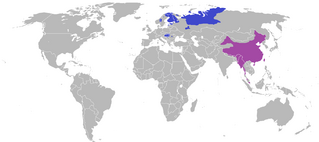Social:Sino-Uralic
| Sino-Uralic | |
|---|---|
| (fringe) | |
| Geographic distribution | Northern Eurasia, East Asia |
| Linguistic classification | Proposed language family |
| Subdivisions | |
| Glottolog | None |
Sino-Uralic or Sino-Finnic is a theory which proposes a link with the Sino-Tibetan languages and Uralic languages. It was suggested by Jingyi Gao and work has also been done by Tõnu Tender. Some proposed evidences are the words kuu 'month' in Finnish and guat 'month' in Minnan, Finnish kieli 'language' and Minnan giân 'speech'.

Gao suggested the proto population could have been living in Neolithic China and carry the Haplogroup N[1][2]
Morrin Swadesh also theorized a more radical and massive Dené-Finnish grouping which also encompasses Sino-Tibetan and Athabaskan.[3]
Evidence
Some shared cognates proposed by Jingyi Gao.[1][2][4]
| Mandarin | Cantonese | Minnan | Estonian | Finnish | North Saami |
|---|---|---|---|---|---|
| àn 'shore' | ngon 'shore' | gaan 'shore' | kallas 'shore' | kallas 'shore' | |
| ián 'speech' | jin 'speech' | giân 'speech' | keel 'language' | kieli 'language' | giella 'language' |
| üe 'month, moon' | jyut 'month' 'moon' | guat/gueh 'month, moon' | kuu | kuu | |
| bie 'other' | bit 'other' | piat 'other' | muu | muu | |
| dui 'correspond' | deoi 'correspond' | tuii 'correspond' | tõsi 'truth' | tosi 'truth' | |
| mo 'foam' | mut 'foam' | buah 'foam' | muohta 'snow' | ||
| zhi 'finger' | zi 'finger' | tsi/ki 'finger' | käe 'hand' | käsi 'hand' | |
| suei 'year old' | seoi 'year old' | sue 'year old' | voos 'year' | vuosi 'year' | |
| suei 'water' | seoi 'water' | tsui 'water' | vesi 'water' | vesi 'water' | |
| jiou 'deep' | gau 'deep' | kiu 'deep' | kaeva 'dig' | kaivaa 'dig' | goaivu 'dig' |
| Mandarin[5] | Cantonese | Finnish | Livonian |
|---|---|---|---|
| [ ʔie ˧˩ ] 'night' | [ je: ] 'night' | yö 'night' | īe 'night' |
| [ pʰa ˧˩ ] 'fear' | [ pʰa ˧ ] 'fear' | pelkä- 'fear' | |
| [ fu: ˧ ] 'dress' | puke- 'dress' | ||
| [ xuo ˧˩] 'or, confused' | [ wak ] 'or, confused' | vai 'or' | või 'or' |
| [ man ˧˦] 'old' | vanha 'old' | vanā 'old' |
| Old Chinese[5] | Proto-Uralic |
|---|---|
| kuun 'big fish' | kala 'fish' |
| pɯn 'slash, burn' | pala 'burn' |
| sqʰuunʔ 'dimihish' | sala 'steal' |
| kʷaaŋ 'sound of stone' | kaja 'echo' |
| hmaaŋ 'desolate' | vaja 'lack' |
Gao also compared Finnish tähti 'star' to Mandarin tai 'extremely' and Minnan thai 'extremely'.[6]
Proposed sound correspondences
Gao suggested Minnan át to correspond to Uralic "uu", for example piát 'other' and muu 'other' and guát 'month' and kuu 'month'.
Another sound correspondence is Mandarin -uei into Finnish osi, for example duei and Finnish tosi
See also
References
- ↑ 1.0 1.1 Tender, Tõnu; Gao, Jingyi (May 2020). "Sino-Uralic etymology for 'moon, month' supported by regular sound correspondences". Researchgate.net. doi:10.24411/2310-2144-2020-00005. https://www.researchgate.net/publication/341756318_Sino-Uralic_etymology_for_'moon_month'_supported_by_regular_sound_correspondences.
- ↑ 2.0 2.1 Gao, Jingyi (January 2020). "Sino-Uralic etymology for 'Jupiter, year' supported by rhyme correspondence". Researchgate.net. doi:10.24411/2310-2144-2020-00002. https://www.researchgate.net/publication/339367067_Sino-Uralic_etymology_for_'Jupiter_year'_supported_by_rhyme_correspondence.
- ↑ Harms, Robert Thomas. "Uralic languages". https://www.britannica.com/topic/Uralic-languages.
- ↑ Gao, Jingyi (December 2019). "On etymology of Finnic term for 'sky'". Researchgate.net. doi:10.24411/2310-2144-2019-00007. https://www.researchgate.net/publication/339168228_On_etymology_of_Finnic_term_for_'sky'.
- ↑ 5.0 5.1 Gao, Jingyi (June 2014). "Rhyme correspondences between Sinitic and Uralic languages: On the example of the Finnish -ala and -aja rhymes". Researchgate.net. doi:10.3176/lu.2014.2.02. https://www.researchgate.net/publication/276024389_Rhyme_correspondences_between_Sinitic_and_Uralic_languages_On_the_example_of_the_Finnish_-ala_and_-aja_rhymes.
- ↑ Gao, Jingyi (September 2020). "(PDF) On etymology of Sinitic, Indo-European and Uralic terms for 'star' supported by regular sound correspondences". Researchgate.net. doi:10.24411/2310-2144-2020-00008. https://www.researchgate.net/publication/344908230_On_etymology_of_Sinitic_Indo-European_and_Uralic_terms_for_%27star%27_supported_by_regular_sound_correspondences.

